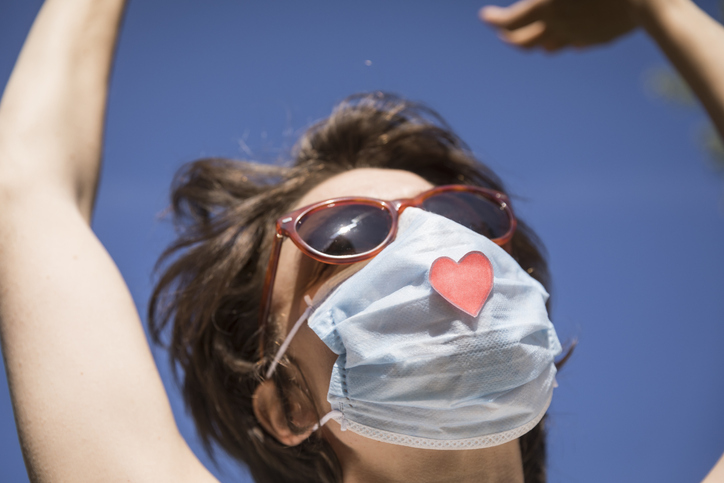
Summer Mask Mania. Here’s What You Need To Know!
By Joy Stephenson-Laws, J.D.,Founder
I didn’t expect my summer wardrobe to include a bunch of face masks, but this is pretty much the norm for all of us as we fight COVID-19. I have a few reusable cloth masks that I can throw in the washer after each use (as recommended).
My latest purchase was a washable brand with extra copper ion infused protection. The addition of copper was especially appealing to me because there is some evidence that copper surfaces may help prevent the rapid spread of some human coronaviruses. Whether this translates to the masks is unclear but in my opinion, having copper included in my mask as an added protection could be a good idea.
Some may feel that the requirement to wear a face mask in public places where it is difficult to practice social distancing is a nuisance or violation of their rights, but the reality is that wearing a face mask may be one of the best ways we can be proactive about protecting one another.
In one report from Stanford Medicine, Dr. Larry Chu said, “We’ve learned that as many as 40% of people infected with the virus that causes COVID-19 may have no symptoms. But when they talk, cough or sneeze, they can still spread the virus to others in the form of respiratory droplets expelled into the air. Those droplets evaporate into fine particles that may linger. The mask traps these larger droplets before they can evaporate. So, wearing a mask regularly can prevent spreading at the source even when we don’t know we are sick.”

There has been a shortage of N95 masks (also called N95 respirators), which healthcare workers desperately need to protect themselves. Due to the shortage, many medical workers have to use surgical masks instead. You can read about the differences between N95 and surgical masks here.
(Instead of a cloth mask, you may be choosing to wear a disposable surgical mask).
“A new analysis of 172 studies, funded by the World Health Organization, confirms what scientists have said for months: N95 and other respirator masks are far superior to surgical or cloth masks in protecting essential medical workers against the coronavirus,” according to a recent report.
Furthermore, the U.S. Food & Drug Administration (FDA) reports, “The Centers for Disease Control and Prevention (CDC) does not recommend that the general public wear N95 respirators to protect themselves from respiratory diseases, including coronavirus (COVID-19). Those are critical supplies that must continue to be reserved for health care workers and other medical first responders, as recommended by current CDC guidance.”
This makes sense. But as I take one of my cloth face masks out of my dryer yet again, I wonder if I’m wearing the most protective cloth that I can. You might be wondering the same, especially if you made your own mask from an old t-shirt or bandana. And what about masks made from synthetic materials?
Not all masks are created equal.A recent study looked at a variety of masks made from natural and synthetic fabrics.
“Of the 32 cloth materials tested, three of the five most effective at blocking particles were 100% cotton and had a visible raised fiber or nap, such as found on flannels,” according to one report discussing the study.
Furthermore, “Four of the five lowest performers were synthetic materials. The testing also showed that multiple fabric layers could improve cotton's effectiveness even further.”
Keep in mind that they did not see improved effectiveness with one layer of cotton and then a layer of synthetic material. So, you may want to go for layers of cotton.
The researchers also observed that tighter woven fabrics overall filtered better than knits and loosely woven fabrics.
“The 100% cotton fabrics with many raised fibers also appeared to filter better than cotton fabrics that lacked this feature. The raised fibers often form web-like structures similar to those in medical grade masks.”
Another study looked at the performance of more than 15 natural and synthetic fabrics such as cotton with different thread counts, silk, flannel and chiffon.
They had some similar findings to the other study mentioned earlier.
“Fabric with tight weaves and low porosity, such as those found in cotton sheets with high thread count, are preferable. For instance, a 600 TPI [threads per inch] cotton performed better than an 80 TPI cotton. Fabrics that are porous should be avoided.”
On the other hand, this study did suggest that making hybrid masks with different layers of materials could be an effective approach. They also found that natural silk and chiffon provided decent protection.
Of course, none of these masks are going to provide 100 percent protection. So it is extremely important to avoid crowds as much as possible, constantly wash your hands and practice social distancing.
Whatever mask you choose, it’s important to make sure that it fits snug and that it covers both your mouth and nose. Having a multi-layered mask also appears to be better.
“Some masks also allow for the ability to insert an additional filter, like a high efficiency particulate air, or HEPA, filter. HEPA filters are designed to clear out at least 99.7 percent of particulates that are 0.3 microns or larger in size,” according to one news report.
But, again...
“While shopping for a face mask, here’s the bottom line: Comfort, washability and dual-filtration is key. But above all else, keep practicing social distancing, washing your hands and taking other precautions, no matter what type of mask you have on.”
Protect yourself by protecting your immune system.
In my opinion, our best COVID defense is immune defense. The truth is that pandemic or no pandemic, we should always be proactive about maintaining a healthy immune system so that our bodies are in the best possible position to fight off all types of disease.
To learn more about how you can help keep your immune system in top shape, check out this pH Labs blog.
Hang in there, and don’t forget your mask before walking out the door!
Enjoy your healthy life!
The pH professional health care team includes recognized experts from a variety of health care and related disciplines, including physicians, attorneys, nutritionists, nurses and certified fitness instructors. This team also includes the members of the pH Medical Advisory Board, which constantly monitors all pH programs, products and services. To learn more about the pH Medical Advisory Board, click here.







